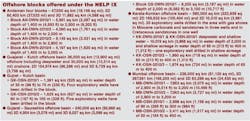Processing advances push technology envelope
Integration, collaboration among keynotes at SEG
Gene Kliewer
Technology Editor, Subsea & Seismic
Two broad topics emerged from the 2010 Society of Exploration Geophysicists Annual Meeting & Exhibition. Amid the amazing technical advancements in data gathering, interpretation, and visualization which have come to be expected from the industry, the ideas of processing “integration” and “collaboration” loom as urgent targets for the entire upstream workflow. And, at the current rate of progress, these are near-term targets.
Processing of seismic data is being upgraded regularly, and the capacity to process data is growing along with it. As indicated in some of the technology descriptions below, data is being turned into more useful information for more disciplines than just geophysics.
Another word now with added meaning in the SEG lexicon is “data.” This now has an extended meaning beyond numbers or points to the notion of getting more value out of a dataset.
Integration means blending together all the available technologies. Here we are talking about integration of programs and suites of programs, not just integration of data. One example is microseismic systems feeding into broad reservoir management programs. Another example is the use of traditional seismic data in conjunction with gravity gradiometry. Where one technique comes up short, the other may fill in the blanks for a more accurate and useful overall representation of the subsurface.
Conventional results (left) compared to BroadSeis (right) offshore West Africa. BroadSeis has achieved nearly six octaves of bandwidth (2.5 – 150Hz) and reveals both fine stratigraphic detail and deep structure. Data courtesy of Total, the Republic of Gabon, and Cobalt.
This trend naturally leads to more collaboration among not only geoscientists, but across a wider range of disciplines. Drillers and production engineers are seeing data presented in such a way as to benefit well planning and life-of-field operations.
As for datasets, the use of original, raw data as input for almost every interpretation method is taken to mean less is lost in the translation from data into 3D representation of the subsoil. This expanded demands from and for datasets brings an equal demand for processing speed in order to make the use of raw data practical for integration and collaboration.
The following is a closer look at some of the technologies featured at SEG 2010.
One big bit of company news coming out of SEG 2010 is that Halliburton’s Landmark and Software Services and LMKR have agreed to accelerate delivery of new software and technology.
“Combining resources for R&D and global marketing will accelerate new technology delivery and reach new customers,” said Gene Minnich, VP, Landmark. “We already are seeing some benefits and updates from the alliance could come as frequently as quarterly.”
Landmark also used the SEG to continue introduction of its new DecisionSpace unified workspace and the most recent element in the company’s “High Science Simplified” plan to make geosciences more accessible. DecisionSpace is an open architecture that permits use of preferred applications and data across domains and vendors.
“DecisionSpace optimizes the workflow to bring out synergy and to bring back the asset team,” said Kenny Laughlin, manager of Geophysics at Landmark.
At the same time, new partner LMKR showcased a new GeoGraphix geomodeling-while-drilling tool. Discovery smartSTRAT is an add-on module to GeoGraphix’s Discovery smartSECTION software. It geomodels while drilling to help geosteer horizontal wells. It offers horizontal well correlation and geosteering tools added to depth-converted seismic backdrops into interpretations. LMKR says this gives an indication of what is ahead of the drill bit so as to avoid hazards and to stay on target.
LMKR also featured its latest geographic information and field planning systems. These allow access and online import of GIS and ArcGIS data into Discovery GeoAtlas where it can be visualized in 2D and 3D.
The use of gravity gradiometry as a complement to seismic surveys was one of ARKeX’s messages. To help with this integration, ARKeX is developing software to take further advantage of the differing data types collected by gravity gradient versus seismic surveys to fill in data that might be missing from either survey for more accurate subsurface identification.
ARKeX also has under development a new survey tool dubbed “EGG” for Exploration Gravity Gradiometer. EGG aims to provide even higher resolution survey data than that now possible. Testing of the new tool is under way.
ARKFIELD interpretation software connects the seismic interpretation to the gravity and magnetic data for higher confidence levels. The company also will interpret the integrated data.
“Gravity gradiometry is a complement to seismic,” said John Siegfried, president and CEO of ARKeX, “and, it is a passive measurement with no environmental impact.”
One technology feature from FairfieldNodal was the use of ocean-bottom nodes to produce development quality surveys rather than exploration quality surveys, says Chris Walker, chief geophysicist, Data Acquisition Division.
One such deepwater Gulf of Mexico project for the cableless nodes is a base line survey for Shell. In a recent “first,” two ROVs were used to place the nodes on the seabed.
FairfieldNodal also is putting survey crews into the field. One is in the GoM and a second team is expected to be at work in the North Sea in 1Q 2011. A third ocean-bottom cableless node survey team using FairfieldNodal equipment is operated by China’s BGP Marine. BGP is conducting survey operations for ARAMCO in the Red Sea.
FairfieldNodal makes two marine versions of its nodes, the Z700 for shallow water to 700 m (2,297 ft) and the Z3000 for depths to 3,000 m (9,842 ft).
A preview of next year’s Paradigm 2011 came from Paradigm at the exhibition.
“Redefining interpretation is the drive for this year and the next,” said Philip Neri, VP of Marketing. “Redefining through iteration will give a constant ‘interpretation’ and SKUA ties all the models together mathematically.
“Looking to the future, in 1Q 2011, Paradigm 2011 will tighten integration, lead to understanding of the data and anomalies, fuel fact-based decisions, and give a clear picture of the uncertainty and risk,” Neri added.
“Paradigm 2011 will take advantage of the Epos IV infrastructure introduced at the SEG annual meeting last year,” said Duane Dopkin, EVP Technology.
The coming release addresses attention to:
- Data size and diversity
- Delivery
- The science behind the interpretations
- The evolution of collaboration.
“The industry is going to petadata with teradata models,” Dopkin said. “On delivery, Paradigm 2011 will work on Windows 7, LINUX, and in high density computing structures. It will give true 3D models and use full azimuth data.”
Key technical advanced in Paradigm 2011 include:
- Pre-stack data in a common interpretation canvas to qualify data assets and prospects
- Angle domain, full azimuth, and anisotropy imaging
- Interactive illumination and reliability assessment of seismic events
- Scalability, adaptability, and open data management
- Concurrent interpretation and geological modeling to predict fault seal, fracture, and spill point probabilities
- Seismic-to-well calibration.
Appro, Intel, and Landmark have teamed to offer a ready-to-run seismic coverage validation engine.
The wave equation-based illumination and visibility software runs on Appro’s pre-configured computing system which is pre-tested and certified Intel Cluster Ready. The software runs on an Appro GreenBlade system based on Intel Xeon processors featuring dual sockets and 32 nodes, with up to 12 CPU per node and 8 GB of memory.
The package can help design 3D seismic surveys and help select processing parameters optimized for geologic targets in difficult areas.
The high-power computing system is a move to keep up with today’s acquisition patterns and uses specific algorithms that leverage the complete power of the system to run efficiently.
CGGVeritas showed results of a survey using BroadSeis offshore Gabon. BroadSeis is a combination of equipment, acquisition techniques, and deghosting and imaging to get a better broadband subsurface image. This follows CGGVeritas’ introduction of the system at EAGE in June.
With its large bandwidth and sharper, clearer wavelet, high-resolution BroadSeis images may reveal shallow features such as thin beds, stratigraphic traps, and potential shallow hazards. BroadSeis acquires both the low and high frequencies simultaneously using Sercel Sentinel solid streamers with a variable depth profile. The cable ghost notch varies along the cable and this notch diversity is used by CGGVeritas’ new deghosting and imaging techniques to produce an ideal wavelet, with the best signal-to-noise ratio and the maximum bandwidth, the company says.
A new OpendTect 4.2 by dGB Earth Sciences debuted in Beta version. The new software comes with new HorizonCube and Well Correlation plug-ins plus interpretation, editing, and visualization features. The commercial version is expected to be available before year-end.
According to dGB, OpendTect 4.2 offers:
- An increase in the number and density of mapped horizons for improved quantitative rock property estimation, better definition of stratigraphic traps, more accurate geological models, and the opportunity to extract more from high-resolution seismic data
- A well correlation tools with a new stratigraphic framework and interactive viewer
- New cross-plotting features
- New visualization, editing, and data integration features.
The recently launched Insight Earth 1.4 was one of TerraSpark Geosciences LLC’s featured products.
“This version offers advancements in horizon edge stacking, Automated Fault Extraction, curvature attributes, horizon dip compensation, and improved velocity modeling,” said Geofrey Dorn, CEO and president.
The horizon edge stacking function, in combination with improvements to TerraSpark’s Automated Fault Extraction, upgrades fault image quality and clarity with higher resolution algorithms and improves the S/N ratio of fault features, including lower angle faults.
Switching to acquisition, PGS has contracted to use Kongsberg Seatex AS’ eBird active positioning streamer control on a Ramform vessel equipped with the latest 3D Geostreamer technology. GeoStreamer is PGS’ multi-component towed streamer.
“PGS has over the past years carried out extensive functional and reliability testing of the Kongsberg eBird system to verify it meets our stringent product qualification standards and operational requirements. eBird has fulfilled our expectations and we are now outfitting our first Ramform vessel with a full eBird installation in line with our strategy to standardize on eBird as the primary system for controlling our GeoStreamer 3D and 4D spreads,” said Nils Lunde, head of Marine Engineering at Petroleum Geo-Services.
Kongsberg’s eBird provides lateral, vertical, and roll control for streamers in marine seismic acquisition.
SEG names awards, honors recipients
A special award was made to Jerome F. Freel in recognition of 75 years of SEG membership. Freel, 98, is thought to be only member for 75 years.
Maurice Ewing Medal: SEG’s highest award went also to M.N. Nafi Toksöz and, in a first, also posthumously to Anthony R. Barringer.
Honorary Membership: SEG’s second highest honor was awarded to Michael S. Bahorich, Walter S. Lynn, and Bjørn Ursin.
Virgil Kauffman Gold Medal: Gerard Thomas Schuster and Kees Wapenaar, for separate contributions to the emerging field of seismic interferometry.
Reginald Fessenden Award: Samuel Gray and Arthur Benjamin Weglein
Life Membership: Bradley A. Birkelo, Steve Danbom, John R. Sumner, and Mary L. Fleming.
J. Clarence Karcher Award: Deyan Draganov and Jeffrey Shragge as outstanding geophysicists under the age of 35.
Offshore Articles Archives
View Oil and Gas Articles on PennEnergy.com


